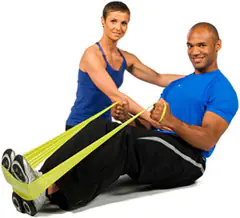The sports equipment discussed in this article is, in essence, similar to the spring expander we discussed earlier. Such sports equipment is usually a wide, elastic rubber band, the length of which can be independently adjusted using a grip, thereby adjusting the degree of load. You can also increase (or decrease) the resistance force by folding the tourniquet in half, three times, and so on. More expensive variations of the accessory are equipped with special handles and are practically no different from spring expanders...
In addition to a comfortable grip, another advantage of this version of the sports equipment is that when using a classic spring expander during training with constant extension and compression of the springs in each repetition of the approach, there is a high probability of pinching the skin, especially in exercises with close contact of the equipment with the body (for example , arm raises in front of the chest, or triceps presses to the sides while holding the apparatus behind your back). Rubber shock absorbers for fitness are free from such disadvantages, and you will never pinch yourself while performing any set, and, therefore, will not damage your skin with an unpleasant bruise or subcutaneous hematoma. Of course, these are all little things, and very subjective, but for the fair sex, I think it will be an important point. Girls are terribly afraid of bruises and always want to look beautiful and flawless...
Another important point in choosing a rubber band instead of a spring counterpart is the price. Naturally, a piece of elastic, even a long one, will cost several times less than chrome springs, and even with fasteners, and even with rubberized handles, so we won’t dwell on this for long. The only thing I would like to mention is that the spring projectile, despite its high cost, has greater strength and durability. But over time, rubber bands, no matter how you look at them, tear, lose their rigidity, stretch, and so on... And therefore, you will have to buy them much more often. Therefore, it is not yet clear whether rubber bands or spring equipment are more economical...
For the deltoid, teres minor and major muscles:
1. Vertical position, legs apart shoulder-width apart, place your feet in the middle of the shock absorber, holding the ends of the projectile in your lowered hands in the “at the seams” position. Raise your straightened arms forward and up above your head and lower them smoothly.
2. The same, raising straight arms through the sides up.
3. Do the same, raising your arms forward and lowering them to the sides.
4. While standing, hold the shock absorber in a horizontal position, gripping it approximately shoulder-width apart, with your arms straight ahead. It is necessary, without bending your elbows, to spread your arms to the sides directly in front of your chest - inhale, bring them together - exhale.
5. Standing with the shock absorber in front of you, your left arm is straightened, vertically lowered and pressed against the front of the thigh, your right arm is parallel to the floor and straightened forward. The shock absorber is easily tensioned. It is necessary to raise your right hand as high as possible, and then smoothly return it to its original position. Repeat, changing the position of your hands.
6. With your feet apart, the shock absorber in straightened arms parallel to the floor above your head. Raising straight arms to the sides.
7. Stand facing a shock absorber mounted on the wall at head level, holding its ends in your hands, extended forward. Lowering your arms down, move them back without bending your torso.
For biceps:
8. Standing in the middle of the shock absorber, holding the ends of the projectile in your lowered hands, grasping them with your palms facing outward. Flexion and extension of the arms (simultaneous and alternate).
9. The starting position is the same, palms inward. Pulling the projectile until the palm touches the chin (“analogue of standing rows”).
For triceps:
10. Stand in the middle of the shock absorber, holding the ends in bent arms, palms facing out, elbows up. Simultaneous and alternate straightening of arms upward. Keep your elbows high and motionless.
12. Standing with the ends of the shock absorber attached to the ceiling in your hands. Leaning forward, straighten your arms down.
13. The same, squatting with the arms extended downwards.
For the press:
14. Stand with your back to a shock absorber attached at waist level and tied at both ends to the foot of your right leg. Swing your right foot forward. The same thing, changing the leg.
15. Standing with your back to the shock absorber mounted on the wall, take its ends in your hands, bent in front of your chest. Turns the body, leaning forward, left and right.
For back muscles:
16. Standing facing a shock absorber fixed at floor level and tied at both ends to the foot of the right foot. Swing your right leg back. The same, with the other leg.
Stand facing the shock absorber mounted on the wall at head level, taking its ends in your hands. Leaning back, bend your arms to your chest, bending and moving your head back.
When regularly training with elastic bands, we also recommend that you work on a punching bag - such a comprehensive and integrated approach will make your blow truly indestructible. Isn’t this what every man dreams of? See a large selection of boxing gloves here; purchasing a punching bag is also not a problem these days, but read about how to hang it correctly in our upcoming articles. There is still a lot of interesting things ahead...
Post Views: 104


